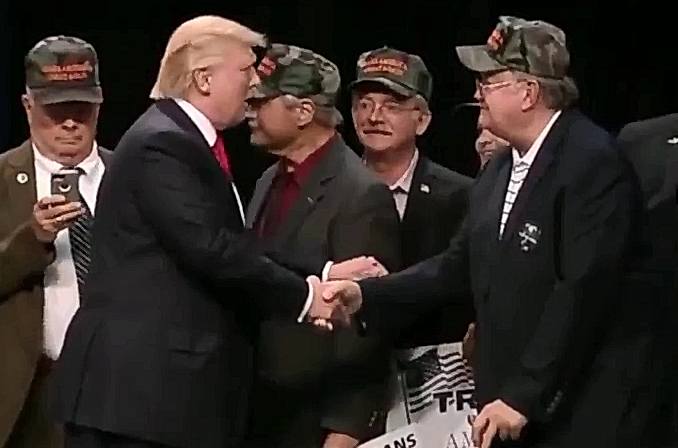By Natalia Castro
Congress and President Donald Trump have worked together for the last two years to promote efficiency at the Department of Veteran Affairs (VA); unfortunately, recent reports reveal optimal care for our veterans cannot be achieved in the public sector alone. With the passage of the VA Maintaining Internal Systems and Strengthening Integrated Outside Networks (MISSION) Act, Congress and the President are giving veterans a chance to receive the best care possible.
The VA is one of the most scandal prone agencies; from accounts of veterans dying on wait lists to reports of prescription drugs being taken from facilities, the American people have had reason to wonder if the agency is really serving the needs of our veterans. Despite the passage of accountability and workforce reforms last year, newest reports reveal the VA is still not meeting the needs of veterans. Although this time, it is not a personnel problem but a structural problem.
Previously, eligible veterans could receive care from community providers through the Veterans Choice Programs when care was deemed not readily accessible through a VA medical facility.
The Government Accountability Office (GAO) found in a June 2018 report, “Veterans who are referred to the Choice Program for routine care because services are not available at VA in a timely manner could potentially wait up to 70 calendar days for care… This is not consistent with the statutory requirement that veterans receive Choice Program care within 30 days of their clinically indicated date… For example, when GAO analyzed 55 routine care authorizations that were created between January and April of 2016, it found that the process took at least 64 calendar days, on average.”
The GAO blames “complexities of referral and appointment scheduling processes”, poor communication between administrators, and an “insufficient number, mix, or geographic distribution of community providers” on the lengthy wait times veterans continue to experience.
Essentially, while the VA Choice Program allowed for private sector involvement in veteran’s care, it kept the care so closely monitored by the federal government that it took far too long to materialize. As a result, the VA Choice Program was allowed to expire this year and be replaced by the VA MISSION Act.
Senate Committee on Veterans’ Affairs Chairman Johnny Isakson (R-Ga.) explained in a Committee report, some of the benefits of the MISSION Act include:
- It authorizes access to walk-in community clinics for enrolled veterans who have previously used VA healthcare services in the last two years;
- It authorizes local provider agreements to remove bureaucratic red tape and to meet veterans’ needs for care in the community;
- It requires the VA to monitor the program and report to Congress on the care provided to veterans;
- It requires the VA to establish and submit to Congress a strategy to ensure all VA and community care programs are operating efficiently and effectively based on a number of factors including veterans’ satisfaction and access guidelines and quality standards, among others; and
- It ensures providers removed or suspended from VA practice do not treat veterans in the community.
All these measures and many more within the legislation, assisting the private sector in being able to better attend to the needs of our veterans. The legislation also strengthens the partnership between the VA and health care providers to prescribe opioids to veterans to ensure veterans do not fall into addiction.
As well as increasing private sector access to care for veterans, the MISSION Act also improves the VA’s internal health network. The law removes barriers for VA professions to practice telemedicine, expands access to caregiver services, allows the VA to provide transplant procedures on live donors, and strengthens the VA’s ability to modernize their assets and health infrastructure.
While President Trump has heralded the legislation as giving “freedom to our amazing veterans” but the White House still wants Congress to fund the law’s projected $50 billion price tag with offsetting spending cuts.
In a memo issued by the administration obtained by the Washington Post, the White House described this funding proposal as “anathema to responsible spending” and called for spending cuts to cover the costs rather than increased spending.
Luckily, one need not look further than the President’s own budget to see where these cuts can come from.
In the FY2019 presidential budget proposal, President Trump offered $2.276 million in budget cuts from the Department of Veteran Affairs alone. While this does not completely cover the costs of the MISSION Act, it is a necessary first step in reigning in agency waste. Present Trump also recommended $50.180 billion in budget cuts arising from reforms to federal retirement programs. These cuts would provide the necessary funding to properly implement the MISSION Act.
With the passage of the MISSION Act, the VA will take a step toward being an agency that effectively serves our veterans. The Department of Veteran Affairs has long acted as essentially socialized medicine, but that structure has failed the people it was meant to assist. By increasing private sector partnerships through community provided care, the VA can better serve its veterans without increasing spending. Now Congress must step in and responsibly pay for it with offsetting spending cuts.
Natalia Castro is a contributing editor at Americans for Limited Government.







